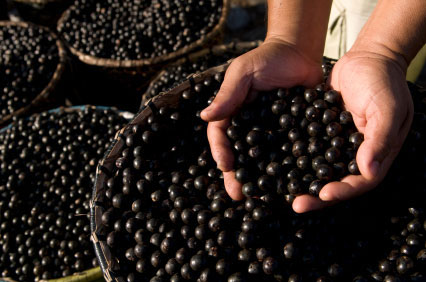Antioxidant-Rich Açaí Berries

Acai berries are the quintessential antioxidant superfood. A deep, purplish-red berry about the size of a large blueberry, this energy-infused fruit comes from sixty-foot-tall palm tree in the Amazonian rainforest. These colorful berries have been used by Brazilian traditional societies for everything from digestive upset to skin problems for years and years.
Not only has this berry been marketed as one of the healthiest foods in the world, scientific studies are beginning to back up these claims. Chocked full of antioxidants, açaí berries also contain an astounding concentration of health-boosting amino acids and essential fatty acids. A ground-breaking study from the University of Florida found that the berry showed the ability to literally destroy human cancer cells.
The following article will look into the composition of the berry, as well as the reported scientific health benefits associated with acai.
The Composition of an Acai Berry
Acai berries are composed of pigment-rich anthocyanins and antioxidants. Containing more than ten times the concentrations of antioxidants as red wine, acai also contain phytosterols, a chemical component known to promote both cardiovascular and digestive health. Acai is also high in monounsaturated oleic acid, palmitic acid, linoleic acid, and beta-sitosterol. Within these oil compartments lie the polyphenols of the fruit. These are the substances which hold the antioxidant components.
The acai fruit is composed of elemental antioxidants known as flavonoids. These are anthocyanins (ACNs) and proanthocyanidins (PACs). The essential fatty acids contained in the fruit and seeds help the body to maintain its metabolic processes. They also keep the skin, the body’s largest organ, smooth and supple. The seeds of the acai plant also hold tremendous benefits for human health. Each tiny seed packs a large amount of procyanidins, protocatechruic acid, and epicatechi. Each of these chemicals are essential for antioxidant neutralization of free radicals.
Studies have shown that acai does acts as a powerful anti-inflammatory, in addition to its antioxidant capacities. In groundbreaking studies on the fruit, powerful mechanisms of action were observed. These in-vitro studies found that acai berry could stop the production of toxic amounts of nitric oxide, as well as cyclooxygenases. It also had the ability to catalyze a process called apoptosis in HL-60 leukemia cells. This caused the leukemia cancerous cells to deactivate and die out. Acai was also able to cause a caspase 3 activation in cancerous cells, a process linked to the creation of proteins necessary for optimal cellular functioning. Eating moderate amounts of acai also induced an increased level of antioxidants in the plasma of the body.
Reported Health Benefits of Acai Berry
In addition to the aforementioned antioxidant effects, acai berry is also high in monounsaturated oleic acid, a type of oil similar to  olive oil. This unique oil has a tenderizing affect on the cell walls, aiding the body in allowing lipids to move seamlessly through the cell’s membranes. By keeping the cell membrane supple, all hormones, neurotransmitters and insulin receptors function more efficiently. This is particularly important due to the fact that high insulin levels create an inflammatory state. And as we know, inflammation causes aging.
olive oil. This unique oil has a tenderizing affect on the cell walls, aiding the body in allowing lipids to move seamlessly through the cell’s membranes. By keeping the cell membrane supple, all hormones, neurotransmitters and insulin receptors function more efficiently. This is particularly important due to the fact that high insulin levels create an inflammatory state. And as we know, inflammation causes aging.
Studies on Acai Berry:
Talcott, et. al (2001) found that the antioxidant and nutritional components in the pulp and juice of the berry had cancer-fighting effects in laboratory studies. The berries were shown to trigger a response in over 85% of leukemia cells that caused them to self-destruct.
Other studies have shown that acai has a particularly strong antioxidant affect on superoxide, peroxyl and peroxynitrite radicals.
Studies have shown that levels of antioxidants in the blood antioxidant increases within two hours of drinking one type of commonly-sold açai juice.
Other research even suggests that açaí powder may not only kill cancer cells, but may also reduce the proliferation of leukemia cells to other areas of the body, in lab studies.
Other possible health benefits of Acai Berries include:
- Free radical scavenging activity, due to extremely high antioxidant content, which may aid in preventing many degenerative diseases
- Unique combination of essential amino acid complex and trace minerals aid in muscle health and regeneration
- High absorbability in the human body (allowing the body to synthesize its valuable antioxidant properties)
- Aids in skin pliability, providing many of the necessary essential fatty-acids to prevent premature aging, sagging skin and wrinkles
- Metabolism booster
- Appetite suppression mechanisms that aid individuals who need weight loss
- Improved digestive capacities
- Aids in the detoxification of the body through its high fiber content
- May improve the overall appearance of the skin, due to high antioxidant qualities
- May aid in improved heart health
- May aid to reduce cholesterol levels
- May aid in the prevention of cancer, heart disease, and stroke
- May aid in reducing loose stools and diarrhea
- May reduce the incidence of allergies
Side Effects and Contraindications
Because of its extremely concentrated antioxidant effects, if you are taking chemotherapy drugs, this supplement or food should be avoided. Also, the berry may suppress the appetite.



